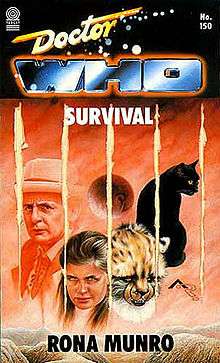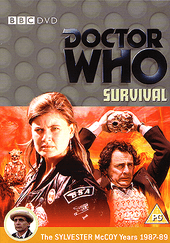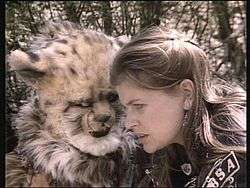Survival (Doctor Who)
| 155[1] – Survival | |||||
|---|---|---|---|---|---|
| Doctor Who serial | |||||
|
Karra and Ace on the cheetah planet. | |||||
| Cast | |||||
|
Others
| |||||
| Production | |||||
| Directed by | Alan Wareing | ||||
| Written by | Rona Munro | ||||
| Script editor | Andrew Cartmel | ||||
| Produced by | John Nathan-Turner | ||||
| Incidental music composer | Dominic Glynn | ||||
| Production code | 7P | ||||
| Series | Season 26 | ||||
| Length | 3 episodes, 25 minutes each | ||||
| Date started | 22 November 1989 | ||||
| Date ended | 6 December 1989 | ||||
| Chronology | |||||
| |||||
Survival is the final serial of the 26th season and also the final story of the original 26-year run in the British science fiction television series Doctor Who, which was first broadcast in three parts, weekly, from 22 November to 6 December 1989. It marks the final regular television appearance of Anthony Ainley as the Master and of Sophie Aldred as Ace. It is also the last to entirely feature Sylvester McCoy as the Seventh Doctor, although he would return briefly in the 1996 TV movie.
Plot
The Seventh Doctor brings Ace back home to Perivale in west London. The suburb is not as it should be: a mysterious black cat is wandering around, somehow creating a situation in which humans are hunted down and made to disappear to another dimension. Ace becomes worried when most of her old friends seem to have disappeared, but the Doctor is more preoccupied with the behaviour of the strange cat. It becomes apparent the black cat is being controlled by a strange being in the other dimension, viewing the scenes in Perivale through the cat's eyes and choosing which humans to chase and transport. An unhappy young man called Stuart becomes his next victim. Ace follows soon afterwards, hunted down by a Cheetah Person on horseback, which seems to have a hunting affinity with the curious cat. Later the Doctor and a keep-fit instructor called Paterson are chosen and teleported to another world, bathed in a blood-red sky, where the Doctor is greeted by his nemesis the Master.
The renegade is evidently unwell, his eyes and mouth displaying feline characteristics, and is using the black cat (or kitling) to create a dimensional bridge for the Cheetah People to hunt prey on Earth. Quite why he is doing this is unclear, other than he seems keen to keep the Cheetah People occupied somehow. He tells the Doctor that the planet is alive and has a bewitching influence; the indigenous population bred the kitlings and had a great civilisation, but they regressed into animals through the power of the planet. He too is beginning to show changes and needs the Doctor's help to escape from the planet.
Ace has meanwhile made contact with some of her friends, Shreela and Midge, who are hiding in some woods with a young man called Derek. The planet is evidently dangerous as both Stuart and a terrified milkman find out when a Cheetah Person hunts him to the death. Ace and her friends soon find the Doctor and Paterson, and the Time Lord has deduced they are on a very ancient planet, which is dying. A Cheetah pack then attacks and during the fight back Midge kills one Cheetah while Ace injures another, called Karra. She begins to form an attachment to Karra and nurses her, tending her injuries, which worries the Doctor greatly. In time Ace's eyes change and she begins to transform into a Cheetah herself. She abandons the Doctor to go hunting with Karra but he eventually wins her round.
Midge has meanwhile completely fallen to the power of the planet and is turning into an animal. The Master seizes on this and uses Midge to teleport them both back to Earth and away from the dying world. The Doctor persuades Ace to help him get back to Perivale and she does so, also enabling Paterson, Derek and Shreela to flee the strange planet. Paterson denies anything amiss has taken place, falling back on his "survival of the fittest" mantras and his self-defence classes. The Doctor and Ace now head around Perivale in search of Midge and the Master. They eventually find them at the youth club, where they have killed Paterson for sport, and Midge too is killed in the Master's machinations. Karra's arrival brings comfort to Ace, whose transformation is continuing, but the Master kills Karra too.
The Master transports the Doctor with him back to the Cheetah Planet for a final conflict but the Doctor resists the pull of the planet, turning away from violence, and is transported away from the dying world. However, the Master looks doomed on the planet as it begins to break up. The Doctor has gone back to the TARDIS and Earth, where he finds Ace, whose metamorphosis has reversed, and tells her she will have grown through the experience: the element of the Cheetah Planet, however, will remain within her forever and they return to the TARDIS.
Continuity
The gap between Survival and the Doctor Who television movie was filled by British publisher Virgin Publishing—who from 1991 to 1997 produced a range of novels entitled the New Adventures—and the Big Finish audio adventures, which are carrying on the adventures of the Doctor and Ace following the end of Survival. The Master would return (played by two different actors) in the 1996 TV film. He is also heard in two audio stories Dust Breeding and Master, which take place after Survival but before the movie.
During the scenes in Midge's flat, Ace grabs War, an album by rock band U2, and says "are they still going?". When Ace left Earth in 1987, the group had been active for eleven years. Ace is seen wearing on her jacket the Red Army pin-on badge given to her by Captain Sorin in The Curse of Fenric.
Production
Writing
Writer Rona Munro approached script editor Andrew Cartmel at a BBC scriptwriting workshop and said that she'd "kill to write for Doctor Who."[2] The story Munro developed incorporated themes including the morals of hunting (personified by the Cheetah People and signposted by Ace's friend Ange collecting for hunt saboteurs).[2] Working titles for the story included Cat-Flap and Blood Hunt.[3] The title Survival was chosen by Cartmel.[2] Munro was disappointed by the realisation of the Cheetah People:
[They] should have just had cheetah eyes and a very faint pigmentation round of cheetah spots, and big canine teeth. And in fact, I think the actors that were cast, from what I was told, were doing all this wonderful expressive facial work, and then these 'Puss In Boots' things were dropped on them – and so then you can't see what they're doing under there. Particularly Karra and Ace, there were whole amazing scenes between them and for me, that was supposed to be my lesbian subtext – and you can't see it!— Rona Munro, 2007 interview[2]
Recording
Survival was one of only three Doctor Who serials to be recorded completely on BBC Outside Broadcast video, instead of the mix of OB and studio video that was more common during the late 1980s, and the mix of film and video that was usual before them. The other stories to be recorded solely on OB video were The Sontaran Experiment (1975) and the previous story The Curse of Fenric (1989).
It was almost 38 °C (100 °F) on the shooting days for the scenes on the planet of the Cheetah people. One of the extras removed her costume (revealing that she was wearing very little underneath) and simply walked off the set, causing delays while a replacement was found.[4] The battle at the climax of the story was recorded and is set on the site of the ancient hill fort at Horsenden Hill, Perivale. The majority of location recording was done in and around Perivale, with small sections shot at nearby Ealing, outside and near The Drayton Court pub.
The final Doctor Who episode in the original series
Having already surmised that episode three of Survival was likely to at least be the last episode of Doctor Who for some time, and possibly the last ever, the programme's producer John Nathan-Turner decided close to transmission that a more suitable conclusion should be given to the final episode.[3] To this end, script editor Andrew Cartmel wrote a short, melancholic closing monologue for actor Sylvester McCoy, which McCoy recorded on 23 November 1989, the day after Episode 1 was broadcast, and also by coincidence, the show's twenty-sixth anniversary:
"There are worlds out there where the sky is burning, the sea's asleep, and the rivers dream. People made of smoke, and cities made of song. Somewhere there's danger, somewhere there’s injustice, and somewhere else the tea's getting cold. Come on, Ace — we’ve got work to do!"
This was dubbed over the closing scene as the Doctor and Ace walked off into the distance, apparently to further adventures. The Doctor Who production office at the BBC finally closed down in August 1990, having been in continuous operation since 1963.
Although Survival was the last Doctor Who serial of the original series to be transmitted, it was not the last to have been produced; that was Ghost Light, which had been broadcast some weeks earlier, as the antepenultimate story of the original run.
This story is the last to feature Anthony Ainley as the Master. Ainley was not asked to return as the Master for the 1996 Doctor Who television movie. Instead, Gordon Tipple was cast as the Master for the prologue and Eric Roberts played the Master for the rest of the movie. Ainley reprised the role of the Master for the 1997 computer game Destiny of the Doctors. He continued to be active in Doctor Who, attending conventions and recording a commentary track for the DVD of the 1981 serial The Keeper of Traken. Ainley died in May 2004.
This story was also the last to entirely feature Sylvester McCoy as the Doctor. McCoy returned briefly to the role at the beginning of the 1996 Doctor Who television movie to regenerate into the Eighth Doctor (played by Paul McGann).
Finally, this story was the last to feature Sophie Aldred as Ace. Aldred would have continued in her role had the series been renewed for Season 27; however, Aldred's contract was set to expire at the middle part of that season. As a result, the character of Ace was set to be written out of the series in an Ice Warrior story called Ice Time (1990) by Marc Platt.[5] According to various interviews with the production team, the new companion would have been a female safecracker whom the Doctor would have taken under his wing, with her gangster father as a recurring character. For details on Doctor Who during the 1990s, see History of Doctor Who.
Both McCoy and Aldred would play their characters on screen for the BBC on two occasions after Survival was broadcast: first in a 1990 episode of the schools and colleges series Search Out Science and once more in 1993, along with many other former Doctor Who actors, in Dimensions in Time, a benefit for Children in Need. The two actors reprised their roles in officially licensed audio productions for Big Finish starting in 1999, and again in 2001 for the BBC webcast production, Death Comes to Time.
Doctor Who eventually returned to production as a BBC television series in 2004, produced by BBC Wales. "Rose", the first episode of the new series, aired on 26 March 2005. As the new series is produced as 45-minute episodes, this makes Survival the final serial to date to be produced in 25-minute instalments, which had been the standard for the series (except for a one-season experiment with 45-minute episodes in 1985) since 1963. This story was also the last to feature the face of the current Doctor in the title sequence, a tradition dating back to The Macra Terror of 1967, until the 2012 Christmas Special and the second part of the 7th series. Both the TV Movie that followed this, and the revived series of 2005 until September 2012, had title sequences featuring a "time tunnel" effect, differing in style from time to time. This effect actually served in-universe as the time-vortex.
Cast notes
The part of Karra in this serial is played by Lisa Bowerman, who is now more familiar to fans as the voice of Bernice Summerfield in the Big Finish Productions audio dramas. She is also a director of many Big Finish productions, and also returned to the Doctor Who series proper when she provided voice-acting work for the animated special Dreamland in 2009.
This serial features guest appearances of the comedians Gareth Hale and Norman Pace, and actress Adele Silva (as an 8-year old, in her first television role). See also Celebrity appearances in Doctor Who.
Broadcast and reception
| Episode | Broadcast date | Run time | Viewers (in millions) |
|---|---|---|---|
| "Part One" | 22 November 1989 | 24:14 | 5.0 |
| "Part Two" | 29 November 1989 | 24:13 | 4.8 |
| "Part Three" | 6 December 1989 | 24:20 | 5.0 |
| [6][7][8] | |||
There was no direct indication given to the public that this was to be the final regular installment of Doctor Who; however, unlike previous years' final episodes, this one featured no announcement in the closing credits that the programme would return the following year.
Reviewing Survival, David J. Howe and Stephen James Walker described it as "a very good story", with a script that contains "highly imaginative and original concepts".[9] They also expressed admiration for the special effects used for the Cheetah People's planet, calling them "superb electronic video effects". Ainley's performance was also praised, with the reviewers stating it was "deadly serious and implacably evil, but with occasional flashes of dark humour".[9] While stating that it was "deeply regrettable" that the original series of Doctor Who had to end with Survival, they added "that it went out on such a high note is, however, something to be thankful for".[9]
The serial was also positively received by Paul Cornell, Martin Day and Keith Topping, who praised Anthony Ainley's performance and considered the show to be "A great end to the series" with "an epic quality".[10]
Commercial releases
In print
 | |
| Author | Rona Munro |
|---|---|
| Cover artist | Alister Pearson |
| Series |
Doctor Who book: Target novelisations |
Release number | 150 |
| Publisher | Target Books |
Publication date | 18 October 1990 |
| ISBN | 0-426-20352-6 |
A novelisation of this serial, written by Rona Munro, was published by Target Books in October 1990, making Munro the third woman to write a Doctor Who novelisation. A reprint edition was one of several possible books included with a 2007 issue of Doctor Who Magazine.
Home media

Survival was released on VHS in October 1995. It was released on DVD on 16 April 2007 as a 2-disc set. This serial was released as part of the Doctor Who DVD Files collection, in issue 51, published 15 December 2010.
References
- ↑ From the Doctor Who Magazine series overview, in issue 407 (pp26-29). The Discontinuity Guide, which counts the four segments of The Trial of a Time Lord as four separate stories and also counts the unbroadcast serial Shada, lists this story as number 159. Region 1 DVD releases follow The Discontinuity Guide numbering system.
- 1 2 3 4 Darlington, David; Rona Munro (25 November 2007). "You're Killing My Lesbian Subtext…!". Deejsaint. Archived from the original on 2011-06-04. Retrieved 2010-01-11.
- 1 2 Survival at Doctor Who: A Brief History of Time (Travel)
- ↑ Interview with Sylvester McCoy on the Survival DVD
- ↑ "Ice Time". Home.earthlink.net. Retrieved 2016-08-15.
- ↑ Shaun Lyon; et al. (31 March 2007). "The Invasion". Outpost Gallifrey. Archived from the original on 22 September 2003. Retrieved 2008-08-30.
- ↑ "The Invasion". Doctor Who Reference Guide. Retrieved 2008-08-30.
- ↑ Sullivan, Shannon (2007-08-07). "The Invasion". A Brief History of Time Travel. Retrieved 2008-08-30.
- 1 2 3 Howe, David, Walker, Stephen James. Doctor Who : The Television Companion. London : BBC Worldwide, 1999. ISBN 0563405880 (pp. 536-37).
- ↑ "Doctor Who Classic Episode Guide - Survival". BBC. Retrieved 2016-08-15.
External links
| Wikiquote has quotations related to: Seventh Doctor |
- Survival at BBC Online
- Survival on TARDIS Data Core, an external wiki
- Survival at the Doctor Who Reference Guide
- Guide to the Perivale locations used in Survival
- Doctor Who Locations - Survival
Reviews
- Survival reviews at Outpost Gallifrey
- Survival reviews at The Doctor Who Ratings Guide
